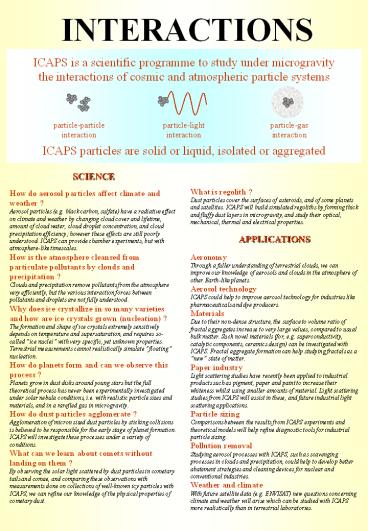INTERACTIONS PowerPoint PPT Presentation
1 / 1
Title: INTERACTIONS
1
INTERACTIONS
ICAPS is a scientific programme to study under
microgravity the interactions of cosmic and
atmospheric particle systems ICAPS particles
are solid or liquid, isolated or aggregated
What is regolith ? Dust particles cover the
surfaces of asteroids, and of some planets and
satellites. ICAPS will build simulated regoliths
by forming thick and fluffy dust layers in
microgravity, and study their optical,
mechanical, thermal and electrical
properties. APPLICATIONS Aeronomy Through a
fuller understanding of terrestrial clouds, we
can improve our knowledge of aerosols and clouds
in the atmosphere of other Earth-like
planets. Aerosol technology ICAPS could help to
improve aerosol technology for industries like
pharmaceuticals and dye producers. Materials Due
to their non-dense structure, the surface to
volume ratio of fractal aggregates increase to
very large values, compared to usual bulk matter.
Such novel materials (for, e.g.
superconductivity, catalytic components, ceramics
design) can be investigated with ICAPS. Fractal
aggregate formation can help studying fractals as
a new state of matter. Paper industry Light
scattering studies have recently been applied to
industrial products such as pigment, paper and
paint to increase their whiteness whilst using
smaller amounts of material. Light scattering
studies from ICAPS will assist in these, and
future industrial light scattering
applications. Particle sizing Comparisons between
the results from ICAPS experiments and
theoretical models will help refine diagnostic
tools for industrial particle sizing. Pollution
removal Studying aerosol processes with ICAPS,
such as scavenging processes in clouds and
precipitation, could help to develop better
abatement strategies and cleaning devices for
nuclear and conventional industries. Weather and
climate With future satellite data (e.g. ENVISAT)
new questions concerning climate and weather will
arise which can be studied with ICAPS more
realistically than in terrestrial laboratories.
SCIENCE How do aerosol particles affect climate
and weather ? Aerosol particles (e.g. black
carbon, sulfate) have a radiative effect on
climate and weather by changing cloud cover and
lifetime, amount of cloud water, cloud droplet
concentration, and cloud precipitation
efficiency however these effects are still
poorly understood. ICAPS can provide chamber
experiments, but with atmosphere-like
timescales. How is the atmosphere cleansed from
particulate pollutants by clouds and
precipitation ? Clouds and precipitation remove
pollutants from the atmosphere very efficiently,
but the various interaction forces between
pollutants and droplets are not fully
understood. Why does ice crystallize in so many
varieties and how are ice crystals grown
(nucleation) ? The formation and shape of ice
crystals extremely sensitively depends on
temperature and supersaturation, and requires
so-called ice nuclei with very specific, yet
unknown properties. Terrestrial measurements
cannot realistically simulate floating
nucleation. How do planets form and can we
observe this process ? Planets grow in dust disks
around young stars but the full theoretical
process has never been experimentally
investigated under solar nebula conditions, i.e.
with realistic particle sizes and materials, and
in a rarefied gas in microgravity. How do dust
particles agglomerate ? Agglomeration of micron
sized dust particles by sticking collisions is
believed to be responsible for the early stage of
planet formation. ICAPS will investigate these
processes under a variety of conditions. What can
we learn about comets without landing on them
? By observing the solar light scattered by dust
particles in cometary tails and comae, and
comparing these observations with measurements
done on collections of well-known icy particles
with ICAPS, we can refine our knowledge of the
physical properties of cometary dust.

